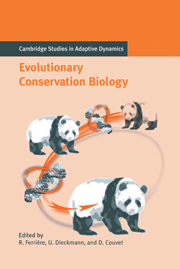Book contents
- Frontmatter
- Contents
- Contributing Authors
- Acknowledgments
- Notational Standards
- 1 Introduction
- Part A Theory of Extinction
- Part B The Pace of Adaptive Responses to Environmental Change
- Part C Genetic and Ecological Bases of Adaptive Responses
- Part D Spatial Structure
- Part E Community Structure
- 16 Coevolutionary Dynamics and the Conservation of Mutualisms
- 17 Ecosystem Evolution and Conservation
- 18 The Congener as an Agent of Extermination and Rescue of Rare Species
- 19 Epilogue
- References
- Index
- The International Institute for Applied Systems Analysis
17 - Ecosystem Evolution and Conservation
Published online by Cambridge University Press: 15 August 2009
- Frontmatter
- Contents
- Contributing Authors
- Acknowledgments
- Notational Standards
- 1 Introduction
- Part A Theory of Extinction
- Part B The Pace of Adaptive Responses to Environmental Change
- Part C Genetic and Ecological Bases of Adaptive Responses
- Part D Spatial Structure
- Part E Community Structure
- 16 Coevolutionary Dynamics and the Conservation of Mutualisms
- 17 Ecosystem Evolution and Conservation
- 18 The Congener as an Agent of Extermination and Rescue of Rare Species
- 19 Epilogue
- References
- Index
- The International Institute for Applied Systems Analysis
Summary
Introduction
A major problem in conservation biology is to decide the target of conservation: should conservation efforts aim to preserve species or ecosystems? The traditional approach has, by necessity, focused on particular species threatened by extinction. With the increasing attention on preserving biodiversity at large, for which the species-by-species approach falls short, a trend is now emerging that centers on ecosystems or habitats as the conservation targets (Schei et al. 1999). These two approaches, however, should not be opposed. Species and ecosystems are bound together by mutual ecological constraints and a shared evolutionary history, so that in the long term it may be impossible to conserve one without conserving the other (Loreau et al. 1995). Species' traits and their evolution are ultimately constrained by ecosystem processes, just as ecosystem properties are constrained by the ecological and evolutionary history of interacting species (Holt 1995). It is the web of interactions at the heart of an ecosystem that maintains both species and ecosystems as they are, or (more exactly) as they are evolving.
Another way to address this problem is to phrase it in terms of a basic issue in evolutionary biology: what are the constraints within which natural selection operates? Traditionally, evolutionists considered these constraints to arise internally, such as from allocations among competing physiological needs. However, feedbacks via ecosystem processes can also act as constraints, and can channel selection in directions that are different from those expected in the absence of such constraints.
Information
- Type
- Chapter
- Information
- Evolutionary Conservation Biology , pp. 327 - 343Publisher: Cambridge University PressPrint publication year: 2004
Accessibility standard: Unknown
Why this information is here
This section outlines the accessibility features of this content - including support for screen readers, full keyboard navigation and high-contrast display options. This may not be relevant for you.Accessibility Information
- 7
- Cited by
